Differential mechanisms of ang (1-7)-mediated vasodepressor effect in adult and aged candesartan-treated rats
- PMID: 22187625
- PMCID: PMC3235484
- DOI: 10.1155/2012/192567
Differential mechanisms of ang (1-7)-mediated vasodepressor effect in adult and aged candesartan-treated rats
Abstract
Angiotensin (1-7) (Ang (1-7)) causes vasodilator effects in Wistar-Kyoto (WKY) rats and spontaneously hypertensive rats (SHRs) via angiotensin type 2 receptors (AT(2)R). However, the role of vascular AT(2)R in aging is not known. Therefore, we examined the effect of aging on Ang (1-7)-mediated vasodepressor effects and vascular angiotensin receptor localization in aging. Blood pressure was measured in conscious adult (~17 weeks) and aged (~19 months) normotensive rats that received drug combinations in a randomised fashion over a 4-day protocol: (i) Ang (1-7) alone, (ii) AT(1)R antagonist, candesartan, alone, (iii) Ang (1-7) and candesartan, or (iv) Ang-(1-7), candesartan, and the AT(2)R antagonist, PD123319. In a separate group of animals, the specific MasR antagonist, A779, was administered in place of PD123319. Receptor localisation was also assessed in aortic sections from adult and aged WKY rats by immunofluorescence. Ang (1-7) reduced blood pressure (~15 mmHg) in adult normotensive rats although this effect was dependant on the background dose of candesartan. This depressor effect was reversed by AT(2)R blockade. In aged rats, the depressor effect of Ang (1-7) was evident but was now inhibited by either AT(2)R blockade or MasR blockade. At the same time, AT(2)R, MasR, and ACE2 immunoreactivity was markedly elevated in aortic sections from aged animals. These results indicate that the Ang (1-7)-mediated depressor effect was preserved in aged animals. Whereas Ang (1-7) effects were mediated exclusively via stimulation of AT(2)R in adult WKY, with aging the vasodepressor effect of Ang (1-7) involved both AT(2)R and MasR.
Figures

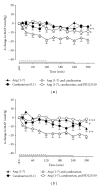
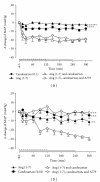
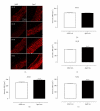
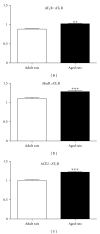
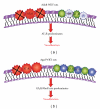
References
-
- Donoghue M, Hsieh F, Baronas E, et al. A novel angiotensin-converting enzyme-related carboxypeptidase (ACE2) converts angiotensin I to angiotensin 1–9. Circulation Research. 2000;87(5):E1–E9. - PubMed
-
- Tipnis SR, Hooper NM, Hyde R, Karran E, Christie G, Turner AJ. A human homolog of angiotensin-converting enzyme—cloning and functional expression as a captopril-insensitive carboxypeptidase. Journal of Biological Chemistry. 2000;275(43):33238–33243. - PubMed
-
- Trask AJ, Ferrario CM. Angiotensin-(1–7): pharmacology and new perspectives in cardiovascular treatments. Cardiovascular Drug Reviews. 2007;25(2):162–174. - PubMed
-
- Santos RAS, Ferreira AJ. Angiotensin-(1–7) and the renin-angiotensin system. Current Opinion in Nephrology & Hypertension. 2007;16(2):122–128. - PubMed
LinkOut - more resources
Full Text Sources
Miscellaneous

